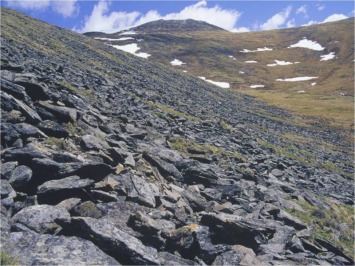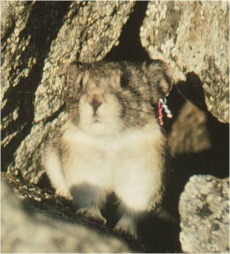Factors Affecting Habitat Occupancy
by the Collared Pika,
A Species at the Coal Face of Climate Change
Collared pikas (Ochotona collaris) and their southern counterparts, American pikas (Ochotona princeps), inhabit some of the most isolated and extreme environments of any mammal in North America. These diminutive and industrious relatives of rabbits and hares are a familiar sight for hikers in subalpine and alpine meadows, where they live beneath boulders in talus patches, nesting in “haypiles” made from vegetation that they have gathered over the snow-free months.

Talus patch in the alpine, Ruby Ranges, Yukon
Pika populations are declining across Canada and the US. The species has been identified as an early harbinger of the negative effects of climate-change. This is because, along with the North and South poles, the high elevation environments that pikas inhabit are expected to experience some of the earliest and most extreme environmental changes as climates warm.

Collared pika with identification tag
In this research project I applied multivariate analyses to explore the relationship between habitat occupancy by collared pikas and a number of spatial, environmental and climate variables. These analyses were applied to data collected from a ten year study in the Ruby Ranges in the Yukon Territory. Data were analyzed at three spatial scales: the study area (metapopulation), talus patch (local population) and haypile (individual pikas).
These analyses indicate that habitat occupancy at the patch scale is influenced by three key factors: the size of talus patches, the connectivity linking patches, and the composition of vegetation within proximity of each patch. At the broader metapopulation scale, the total number of pikas in the study area per year and the number of localized extirpations from patches correlate strongly with winter temperatures and precipitation and the length of the growing season.
These outcomes are consistent with what is know about the biology of collared pikas and demonstrate that habitat and climate factors need to be considered in evaluating and implementing conservation strategies for this endearing species.
These analyses indicate that habitat occupancy at the patch scale is influenced by three key factors: the size of talus patches, the connectivity linking patches, and the composition of vegetation within proximity of each patch. At the broader metapopulation scale, the total number of pikas in the study area per year and the number of localized extirpations from patches correlate strongly with winter temperatures and precipitation and the length of the growing season.
These outcomes are consistent with what is know about the biology of collared pikas and demonstrate that habitat and climate factors need to be considered in evaluating and implementing conservation strategies for this endearing species.
Acknowledgements

..I gratefully acknowledge all of the people who worked so hard to gather the data that I have been so fortunate to use for this project, including David Hik, Renee Franken, Eliot McIntire, Shawn Morrison, Seawan Koh, Vijay Patil, Keiran O’Donovan and the many field technicians who have participated over the years. Thanks you, thank you!!
Many thanks also to the research sponsors shown above.
Many thanks also to the research sponsors shown above.
Disclaimer
This website is a class exercise for RenR 690 at the University of Alberta. Any results and conclusions discussed here are preliminary in nature and will be more fully evaluated at a future date.
